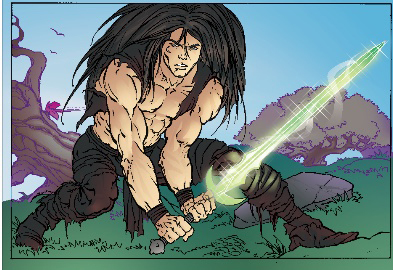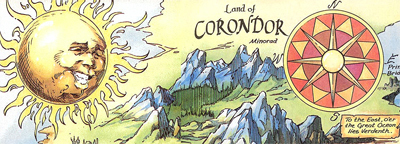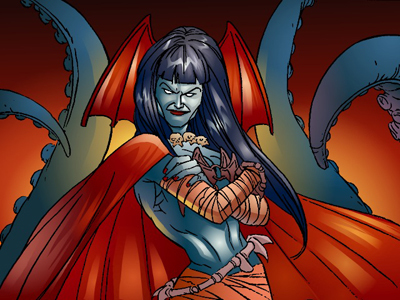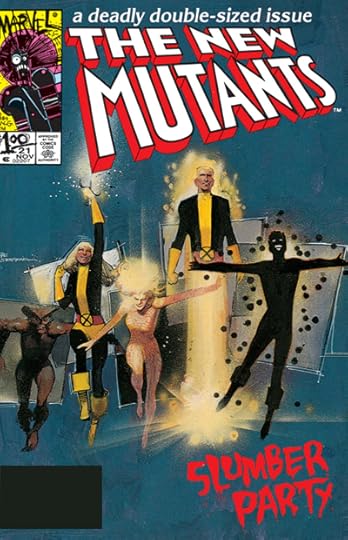MTG Comics Reread: Jeff Gomez Interview
As a capstone to the MTG Comics Reread Project, I had the great pleasure of interviewing Jeff Gomez. Corresponding with Jeff first on Twitter and then via email was a great delight. Getting to pick his brain about the Armada MTG comics was something my younger self could have never imagined when I was buying these comics with my mom all those years ago.
If you’ve been reading these entries as frequently as I’ve been writing them, you know that Jeff was the guiding editorial force behind the Armada MTG comics. An avid gamer, Jeff started his career in gaming journalism at Gateways magazine before moving to Valiant Comics in 1992.
After leaving the comics and video game industry in the late-1990s, Jeff co-founded Starlight Runner Entertainment in 2000 with Mark Pensavalle and Chrysoula Artemis. As CEO, Jeff has helped steer transmedia strategies for Fortune 500 companies like Disney and Sony, and entertainment franchises like Pirates of the Caribbean, Halo, Avatar, and Spider-Man.
In addition to his duties at Starlight Runner, Jeff actively teaches and writes about media and storytelling topics. We conducted this interview via email.

(Jared Carthalion as drawn by Rags Morales for the Battlemage video game. Image courtesy of Jeff Gomez.)
Pat Scalisi: For those who aren’t familiar with the story, can you briefly explain how you got involved in helping create the first-ever Magic: The Gathering comics for Armada in the mid-1990s?
Jeff Gomez: While working at Valiant Comics in the early 1990s, I learned that the video game company Acclaim Entertainment (makers of the Mortal Kombat series) intended to buy Valiant in the hopes of adapting [Valiant’s] superheroes into games. Because of my background in tabletop adventure games and my understanding of video game technology, I volunteered to help select and develop the games from the Valiant side. My pick for the first big Nintendo 64 game was Turok, Dinosaur Hunter, and I submitted a concept document that led to my being a producer on the game. It was a huge success.
Valiant asked me what else outside of their superhero line would make a good comic book and video game combo, and I recommended a trading card game being made by some friends of mine from my days as a tabletop game writer. The game was called Magic: The Gathering, and I knew it was going to be a hit because my schoolteacher friends were already annoyed with kids playing with the cards in class! My bosses at Valiant told me to see what it would take to pick up the game as a license for comics and videogames. They gave me a $300 budget to create a presentation and a roundtrip ticket to Renton, Wash., to visit Wizards of the Coast (WotC).

(The offices of Wizards of the Coast in Renton, Wash. Photo courtesy of Wizards of the Coast.)
In the interim, I checked out what WotC was doing licensing-wise and learned that they had already cut a deal with HarperCollins to publish novels based on the fantasy world alluded to in the cards. One of my best friends, Mark Pensavalle, worked for the publisher, and I got him to sneak me the galley of the first Magic: The Gathering novel, Arena. Reading it, I realized that there was huge potential in building a fantasy world based on the cards, but that these books were not really dealing with the coolest aspects of it, like Planeswalkers and major magic duels. That would be the stuff of comic books and video games!
When I got to WotC, I learned that there was fierce competition for the Magic license from all the comic book companies, including Marvel and DC. I guess what made us stand out was that we also wanted the game license and that I had a lot of experience helping to build expansive fantasy worlds. I also loved the game and had a strong desire to help establish an epic narrative that tied a lot of disparate concepts and wildly different game decks together into a single continuity. How could they resist?
Once they said yes, Valiant turned to me to figure out how to pull all of this off. Finding a writer to create the comics and games so quickly was nearly impossible, so I volunteered to write the comics and games myself, and somehow the powers that be agreed.
They gave me less than a month to have the first script in production as a comic, so I took a shortcut. I went to one of my original Dungeons & Dragons campaign settings, The Land of Corondor, and plopped it down in the middle of Dominaria. That way I could wreck the place and have some creative freedom without messing with the rest of the Magic multiverse too badly.

(Detail of the map of Corondor from Shadow Mage issue 4.)
But soon WotC was giving me the freedom to do some amazing things, like tell the origin story of Dakkon Blackblade and set it on Corondor. They also let me tell stories set elsewhere on Dominaria during the Ice Age era, allowing me to tie my various comic book series together in the form of a grand epic that took place over the course of many centuries. Before long, my team and I were creating canon for the Magic universe, a lot of which persists to this day.
Pat: That’s right! Fast forward nearly 25 years. Wizards of the Coast releases the 2018 Dominaria set, and part of the inciting incident for the plot is drawn directly from the Dakkon Blackblade comic! Could you have imagined that plot threads from the comics would still be impacting Magic’s story more than two decades later?
Jeff: For a while I was melancholy about the notion that my work on Magic: The Gathering would not be remembered. A few of the stories had been retconned out of existence when the franchise took a different creative direction in the late 1990s. But I’ve also been around long enough to see that everything old becomes new again, and that we sometimes look back at things that were meaningful when we were young and want to revisit them. To see this happen with the hard work I did over 20 years ago is simply amazing.


(Top: Geyadrone Dihada, the Planeswalker who manipulated Dakkon into crafting the fearsome Blackblade. Bottom: The Blackblade Reforged from the 2018 Dominaria expansion set. Bottom art by Chris Rahn.)
I love that the Dakkon Blackblade story (which was also the origin story for the whole Carthalion family saga that tied together the comics and video games) is intrinsic to the new Dominaria set. But you know what I love even more? The fact that people like you and Multiverse in Review are revisiting the old work in such a fun, detailed, and passionate way.
Pat: I’m glad you mentioned Multiverse in Review, because that ties into my next question. One of the biggest frustrations for fans to this day is that the comic line came to an abrupt end before the Planeswalker War story could be told in full. Berend at Multiverse in Review did a great job uncovering what might have been. Do you think we’ll ever get an official conclusion to the storyline?
Jeff: Would I like to finish that storyline? Hell, yeah! Running just short of Planeswalker War before cancellation was one of the most crushing disappointments of my career. What’s funny is that the Magic comics were cancelled because they were only selling 40,000 to 60,000 copies a piece. Those would be very respectable numbers for any comic only a year or so later. Heck, they’d be great numbers today!

(The cover to what would have been Planeswalker War issue 1. Art by Rags Morales.)
Planeswalker War could well be rewritten to fit within the parameters of the WotC chronology retcon. We haven’t seen much of Corondor in the lore since, and not all that much has been acknowledged about what happened there in the new Dominaria narratives. So it could well be possible, and I might humbly add, it could be pretty satisfying for all fans. There haven’t been many events in the narrative that have been so colossal in scope.
Pat: Turning to the creative side, some of the folks you worked with — like Val Mayerik and Bill Sienkiewicz — were and continue to be huge names in the fantasy and sci-fi fields. Others were just starting out and went on to have significant careers in comics, advertising, and entertainment. What was it like to work with this unique and talented pool of creators?
Jeff: I had only been a comic book editor for a year or so before Magic came along. Before that I was a collector and enthusiast like any other fan. So the prospect of working with this incredible talent, guys whose work I was staring at in issues of New Mutants or Master of Kung Fu — it was mind-blowing.

(Bill Sienkiewicz’s cover for New Mutants issue 21 during his iconic run on the title.)
When Alex Maleev first came to the office, he showed up at my cubicle because I was one of the only editors who would look at a portfolio from right off the street. I was a bit busy, but he told me, “If you don’t look at my portfolio, I will throw myself out the window.” I looked and gave him Magic: The Gathering’s Fallen Empires almost immediately.
Alex is one of my greatest discoveries. Doug Tropea-Wheatley is another. He did Elder Dragons for me, and I still have his pencil of the two-page Palladia Mors splash hanging in my living room. Charles Vess, Mike Kaluta, Greg Hildebrandt — these were some of the greatest fantasy illustrators of all time. I was in heaven!
Pat: What’s your favorite memory or memories from working on the Magic comic line?
Jeff: The time I spent at WotC feels like a dream. The place was located near these amazing forests. Mount Rainier hovered in the distance like Valhalla and Olympus. Hundreds of cubicles jammed with dragons, movie posters, and fantasy collectibles. Lights dim, sound hushed. Dead Can Dance playing somewhere in the background. And I was there to help figure out how the system of magic worked in the Dominia multiverse. I was there to get permission to put Corondor and the Magic chronology on something new called a “web page.” I was there to help create a brand new fantasy canon that would last for years and years.
The only thing that could remotely rival those days was when I saw my name on the cover of Magic: The Gathering’s The Shadow Mage. There’s Jared Carthalion, with a scar on his face just like mine, a freaky kid whose strongest power was not his innate Planeswalker magic, but his ability to unite other freaky people.

(The Diamond Distribution catalog declares Shadow Mage issue 1 its “Gem of the Month.” “This was one of the most exciting moments of my life!” says Jeff.)
Pat: I know you’re busy with all you do for Starlight Runner Entertainment, so I wanted to thank you for taking the time to chat. So many Magic fans continue to enjoy and read these comics. Many are rediscovering them because of the recent expansions. Is there anything you’d like to say to those fans today?
Jeff: Since Magic, I’ve gotten to work on so many amazing story worlds: Avatar, Pirates of the Caribbean, Halo, Men in Black, Tron, Teenage Mutant Ninja Turtles. But Magic fans have always been special because they seem to understand the nature of my contributions and have appreciated the details and levels of complexity in the work. I think that’s wonderful and so, there’s a special place in my heart for those fans.
Some of them tell me that they wish they could be doing what I do for a living but that it seems impossible. I want to tell you all that it’s not. In fact, nowadays it’s more possible to get involved in entertainment and create great games and story worlds than ever before. The entertainment machine is massive. Companies need new, original content from a diversity of perspectives. So, when I get asked how I managed to do these things, I tell people that it’s pretty simple: I walked up to the things I loved and asked, “How does this work?”

(One of Starlight Runner Entertainment’s case studies.)
After studying how it works and then moving into situations where the work is getting done, I was able to step forward and say, “Yeah, I know how this works.” The money comes when you know how it works so well that you can imitate it and innovate it. You’re making it work.
I studied fantasy roleplaying games because I wondered how they worked. I saw that they were built on systems of rules, that there was a balance to them, numbers before imagination is added. That was what made me able to talk with deep understanding to Richard Garfield, who built Magic on top of algebraic equations. To understand the math is what made Skaff Elias at WotC, and to a certain extent myself, able to help devise the magic system on top of the math.
Card games, films, television, apps, theme park rides — “How does this work?”
When I know how they work (not guessing, knowing), then I can speak to the people involved and not embarrass myself. And they appreciate that I know their language, which they thought was a secret language. So, I get to be part of the club. I get to contribute my ideas. The job is mine to screw up.
It gives me great joy to know that there are fans who still appreciate my work after many years. But it would give me even more satisfaction to know that those fans are living joyous and fulfilling lives. That somehow these fantasies have helped to guide us all toward a better reality.
And feel free to jump on my social media! Twitter: @Jeff_Gomez and Facebook: Starlight Runner Entertainment.

If you’ve been reading these entries as frequently as I’ve been writing them, you know that Jeff was the guiding editorial force behind the Armada MTG comics. An avid gamer, Jeff started his career in gaming journalism at Gateways magazine before moving to Valiant Comics in 1992.
After leaving the comics and video game industry in the late-1990s, Jeff co-founded Starlight Runner Entertainment in 2000 with Mark Pensavalle and Chrysoula Artemis. As CEO, Jeff has helped steer transmedia strategies for Fortune 500 companies like Disney and Sony, and entertainment franchises like Pirates of the Caribbean, Halo, Avatar, and Spider-Man.
In addition to his duties at Starlight Runner, Jeff actively teaches and writes about media and storytelling topics. We conducted this interview via email.

(Jared Carthalion as drawn by Rags Morales for the Battlemage video game. Image courtesy of Jeff Gomez.)
Pat Scalisi: For those who aren’t familiar with the story, can you briefly explain how you got involved in helping create the first-ever Magic: The Gathering comics for Armada in the mid-1990s?
Jeff Gomez: While working at Valiant Comics in the early 1990s, I learned that the video game company Acclaim Entertainment (makers of the Mortal Kombat series) intended to buy Valiant in the hopes of adapting [Valiant’s] superheroes into games. Because of my background in tabletop adventure games and my understanding of video game technology, I volunteered to help select and develop the games from the Valiant side. My pick for the first big Nintendo 64 game was Turok, Dinosaur Hunter, and I submitted a concept document that led to my being a producer on the game. It was a huge success.
Valiant asked me what else outside of their superhero line would make a good comic book and video game combo, and I recommended a trading card game being made by some friends of mine from my days as a tabletop game writer. The game was called Magic: The Gathering, and I knew it was going to be a hit because my schoolteacher friends were already annoyed with kids playing with the cards in class! My bosses at Valiant told me to see what it would take to pick up the game as a license for comics and videogames. They gave me a $300 budget to create a presentation and a roundtrip ticket to Renton, Wash., to visit Wizards of the Coast (WotC).

(The offices of Wizards of the Coast in Renton, Wash. Photo courtesy of Wizards of the Coast.)
In the interim, I checked out what WotC was doing licensing-wise and learned that they had already cut a deal with HarperCollins to publish novels based on the fantasy world alluded to in the cards. One of my best friends, Mark Pensavalle, worked for the publisher, and I got him to sneak me the galley of the first Magic: The Gathering novel, Arena. Reading it, I realized that there was huge potential in building a fantasy world based on the cards, but that these books were not really dealing with the coolest aspects of it, like Planeswalkers and major magic duels. That would be the stuff of comic books and video games!
When I got to WotC, I learned that there was fierce competition for the Magic license from all the comic book companies, including Marvel and DC. I guess what made us stand out was that we also wanted the game license and that I had a lot of experience helping to build expansive fantasy worlds. I also loved the game and had a strong desire to help establish an epic narrative that tied a lot of disparate concepts and wildly different game decks together into a single continuity. How could they resist?
Once they said yes, Valiant turned to me to figure out how to pull all of this off. Finding a writer to create the comics and games so quickly was nearly impossible, so I volunteered to write the comics and games myself, and somehow the powers that be agreed.
They gave me less than a month to have the first script in production as a comic, so I took a shortcut. I went to one of my original Dungeons & Dragons campaign settings, The Land of Corondor, and plopped it down in the middle of Dominaria. That way I could wreck the place and have some creative freedom without messing with the rest of the Magic multiverse too badly.

(Detail of the map of Corondor from Shadow Mage issue 4.)
But soon WotC was giving me the freedom to do some amazing things, like tell the origin story of Dakkon Blackblade and set it on Corondor. They also let me tell stories set elsewhere on Dominaria during the Ice Age era, allowing me to tie my various comic book series together in the form of a grand epic that took place over the course of many centuries. Before long, my team and I were creating canon for the Magic universe, a lot of which persists to this day.
Pat: That’s right! Fast forward nearly 25 years. Wizards of the Coast releases the 2018 Dominaria set, and part of the inciting incident for the plot is drawn directly from the Dakkon Blackblade comic! Could you have imagined that plot threads from the comics would still be impacting Magic’s story more than two decades later?
Jeff: For a while I was melancholy about the notion that my work on Magic: The Gathering would not be remembered. A few of the stories had been retconned out of existence when the franchise took a different creative direction in the late 1990s. But I’ve also been around long enough to see that everything old becomes new again, and that we sometimes look back at things that were meaningful when we were young and want to revisit them. To see this happen with the hard work I did over 20 years ago is simply amazing.


(Top: Geyadrone Dihada, the Planeswalker who manipulated Dakkon into crafting the fearsome Blackblade. Bottom: The Blackblade Reforged from the 2018 Dominaria expansion set. Bottom art by Chris Rahn.)
I love that the Dakkon Blackblade story (which was also the origin story for the whole Carthalion family saga that tied together the comics and video games) is intrinsic to the new Dominaria set. But you know what I love even more? The fact that people like you and Multiverse in Review are revisiting the old work in such a fun, detailed, and passionate way.
Pat: I’m glad you mentioned Multiverse in Review, because that ties into my next question. One of the biggest frustrations for fans to this day is that the comic line came to an abrupt end before the Planeswalker War story could be told in full. Berend at Multiverse in Review did a great job uncovering what might have been. Do you think we’ll ever get an official conclusion to the storyline?
Jeff: Would I like to finish that storyline? Hell, yeah! Running just short of Planeswalker War before cancellation was one of the most crushing disappointments of my career. What’s funny is that the Magic comics were cancelled because they were only selling 40,000 to 60,000 copies a piece. Those would be very respectable numbers for any comic only a year or so later. Heck, they’d be great numbers today!

(The cover to what would have been Planeswalker War issue 1. Art by Rags Morales.)
Planeswalker War could well be rewritten to fit within the parameters of the WotC chronology retcon. We haven’t seen much of Corondor in the lore since, and not all that much has been acknowledged about what happened there in the new Dominaria narratives. So it could well be possible, and I might humbly add, it could be pretty satisfying for all fans. There haven’t been many events in the narrative that have been so colossal in scope.
Pat: Turning to the creative side, some of the folks you worked with — like Val Mayerik and Bill Sienkiewicz — were and continue to be huge names in the fantasy and sci-fi fields. Others were just starting out and went on to have significant careers in comics, advertising, and entertainment. What was it like to work with this unique and talented pool of creators?
Jeff: I had only been a comic book editor for a year or so before Magic came along. Before that I was a collector and enthusiast like any other fan. So the prospect of working with this incredible talent, guys whose work I was staring at in issues of New Mutants or Master of Kung Fu — it was mind-blowing.

(Bill Sienkiewicz’s cover for New Mutants issue 21 during his iconic run on the title.)
When Alex Maleev first came to the office, he showed up at my cubicle because I was one of the only editors who would look at a portfolio from right off the street. I was a bit busy, but he told me, “If you don’t look at my portfolio, I will throw myself out the window.” I looked and gave him Magic: The Gathering’s Fallen Empires almost immediately.
Alex is one of my greatest discoveries. Doug Tropea-Wheatley is another. He did Elder Dragons for me, and I still have his pencil of the two-page Palladia Mors splash hanging in my living room. Charles Vess, Mike Kaluta, Greg Hildebrandt — these were some of the greatest fantasy illustrators of all time. I was in heaven!
Pat: What’s your favorite memory or memories from working on the Magic comic line?
Jeff: The time I spent at WotC feels like a dream. The place was located near these amazing forests. Mount Rainier hovered in the distance like Valhalla and Olympus. Hundreds of cubicles jammed with dragons, movie posters, and fantasy collectibles. Lights dim, sound hushed. Dead Can Dance playing somewhere in the background. And I was there to help figure out how the system of magic worked in the Dominia multiverse. I was there to get permission to put Corondor and the Magic chronology on something new called a “web page.” I was there to help create a brand new fantasy canon that would last for years and years.
The only thing that could remotely rival those days was when I saw my name on the cover of Magic: The Gathering’s The Shadow Mage. There’s Jared Carthalion, with a scar on his face just like mine, a freaky kid whose strongest power was not his innate Planeswalker magic, but his ability to unite other freaky people.

(The Diamond Distribution catalog declares Shadow Mage issue 1 its “Gem of the Month.” “This was one of the most exciting moments of my life!” says Jeff.)
Pat: I know you’re busy with all you do for Starlight Runner Entertainment, so I wanted to thank you for taking the time to chat. So many Magic fans continue to enjoy and read these comics. Many are rediscovering them because of the recent expansions. Is there anything you’d like to say to those fans today?
Jeff: Since Magic, I’ve gotten to work on so many amazing story worlds: Avatar, Pirates of the Caribbean, Halo, Men in Black, Tron, Teenage Mutant Ninja Turtles. But Magic fans have always been special because they seem to understand the nature of my contributions and have appreciated the details and levels of complexity in the work. I think that’s wonderful and so, there’s a special place in my heart for those fans.
Some of them tell me that they wish they could be doing what I do for a living but that it seems impossible. I want to tell you all that it’s not. In fact, nowadays it’s more possible to get involved in entertainment and create great games and story worlds than ever before. The entertainment machine is massive. Companies need new, original content from a diversity of perspectives. So, when I get asked how I managed to do these things, I tell people that it’s pretty simple: I walked up to the things I loved and asked, “How does this work?”

(One of Starlight Runner Entertainment’s case studies.)
After studying how it works and then moving into situations where the work is getting done, I was able to step forward and say, “Yeah, I know how this works.” The money comes when you know how it works so well that you can imitate it and innovate it. You’re making it work.
I studied fantasy roleplaying games because I wondered how they worked. I saw that they were built on systems of rules, that there was a balance to them, numbers before imagination is added. That was what made me able to talk with deep understanding to Richard Garfield, who built Magic on top of algebraic equations. To understand the math is what made Skaff Elias at WotC, and to a certain extent myself, able to help devise the magic system on top of the math.
Card games, films, television, apps, theme park rides — “How does this work?”
When I know how they work (not guessing, knowing), then I can speak to the people involved and not embarrass myself. And they appreciate that I know their language, which they thought was a secret language. So, I get to be part of the club. I get to contribute my ideas. The job is mine to screw up.
It gives me great joy to know that there are fans who still appreciate my work after many years. But it would give me even more satisfaction to know that those fans are living joyous and fulfilling lives. That somehow these fantasies have helped to guide us all toward a better reality.
And feel free to jump on my social media! Twitter: @Jeff_Gomez and Facebook: Starlight Runner Entertainment.

Published on August 12, 2018 13:17
•
Tags:
comic-books, comics, magic-the-gathering, mtg, wizards-of-the-coast, wotc
No comments have been added yet.



